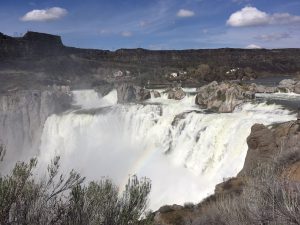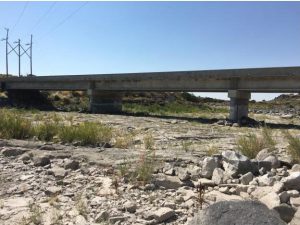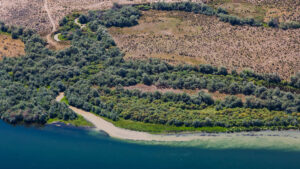This week (March 10-16, 2024) is National Groundwater Awareness Week, an annual observance to highlight the responsible development, management, and use of groundwater. ICL will be doing a series of blog posts this week to highlight Idaho’s precious groundwater resources.
The Snake River is one of the most important rivers of the West. It rises in the mountains of western Wyoming and flows through Idaho and Oregon before emptying into the Columbia River in Washington. At 1,078 miles long, this bountiful river has provided for both humans and wildlife alike for centuries.
For many people, the Snake River is famous for carrying salmon to the ocean or for the world-class adventures in its rapids. In southern Idaho, the Snake River flows across some of the most arid land in the western United States, and yet has managed to transform this desert landscape into an agricultural powerhouse. While the Snake River and its neighboring aquifer (the Eastern Snake Plain Aquifer) have helped humans thrive and prosper for generations, it hasn’t always been easy…
A human history
Native Americans have lived along the Snake for more than 14,000 years. The Shoshone Tribe inhabited a vast region of land in southern and eastern Idaho, including along the Snake River. Salmon were a vital resource for the Tribe, with salmon runs historically going upstream on the Snake all the way to the natural barrier of Shoshone Falls near the present-day city of Twin Falls.

Some of the first written descriptions of the Shoshone Tribe appear in the journals of Lewis and Clark, who encountered the Shoshone on their journey through Idaho in 1805 and 1806. As more explorers and fur trappers came over the years, the Snake River provided water and food in a harsh desert landscape.
Members of the Bannock Tribe also resided in the Great Basin, in what is now southern Idaho, northern Nevada, Oregon and western Wyoming. They relied upon salmon in the Snake River for generations before Europeans arrived, hunted buffalo and other wildlife, and traded across the region.
Following the Lewis and Clark expedition, more trappers, fur traders and missionaries traveled west on foot and horseback. Some of the trails they used later became portions of the Oregon Trail. By the mid-1800s, the Oregon Trail was well established and generally followed much of the Snake River.
Conflicts between Europeans and members of both the Shoshone and Bannock Nations led to escalating tensions, and in 1863 over 250 members of the Shoshone village of Bear River were massacred at a site that is now protected as a National Historic Site. In 1868, the Fort Bridger Treaty was signed between the United States and the Eastern Band Shoshoni and Bannock Nations, establishing the Fort Hall Reservation; many members of the Shoshone-Bannock Tribes were relocated. The city of Fort Hall is the current headquarters of the Shoshone-Bannock Tribes.
Making magic
Before significant human intervention, much of the Snake River Plain was arid, uninhabitable land. Over time, canals were built, dams were constructed, and canals were dug – utterly transforming the landscape. The significant diversion of water from the Snake River and pumping of water from the Eastern Snake Plain Aquifer (ESPA) has turned the region into the heartland of Idaho’s agricultural economy.
The ESPA lies beneath the Snake River Plain and is the largest aquifer in Idaho. It covers nearly 11,000 square miles in southern Idaho and has supplied drinking water for thousands of years. Both the ESPA and the Snake River helped settlers prosper in the region – but it came at a cost.
The first people to divert the Snake River in eastern Idaho were Mormon settlers in the 1860s, who were trying to serve farmers’ needs in dry years. More irrigation systems were built after Congress passed the Carey Act in 1894, which allowed private companies to erect irrigation systems and profit from water sales. New water infrastructure attracted more farmers to the region.
Milner Dam, one of the most successful Carey Act projects, was built near Twin Falls in 1905. During most summers, it completely diverted the Snake to provide water to thousands of miles of canals. This marked the first time Shoshone Falls ran dry.

In 1902, the federal government started to help fund the construction of irrigation projects after the Newlands Reclamation Act (NRA) was passed.
In 1904, the Bureau of Reclamation established the Minidoka Project, which was a series of public works aimed to control the flow of the Snake River and supply irrigation water to Idaho farmlands. The project involved a series of dams and canals, and began with the construction of Minidoka dam at Lake Walcott in 1906. Jackson Lake Dam was built shortly after. Together, these dams provided enough water storage to turn uninhabited sagebrush desert into bountiful farmland. This seemingly “magic” transformation gave the Magic Valley its name, and led to further settlement of the region.
At what cost?
This transformation from sagebrush desert to bountiful farmland has not come without a cost, however. The shift to widespread irrigated agriculture in southern Idaho, while bringing economic prosperity, has also had negative impacts on both the Snake River and the ESPA. The flood irrigation techniques commonly used in the region until recent decades severely polluted the Snake River with sediment and phosphorus. The industrialized dairy industry grew rapidly in the 1990s with the promise of abundant water and few regulations in southern Idaho.

To keep up with the growing agricultural industry, the state also tapped into groundwater in the ESPA in the 1970s. By the 1990s, levels in the ESPA had declined so low, due to pumping, that it was hurting the Snake River and surface water users in the region. In 1992, the state issued a moratorium on new water rights in the Snake River Basin upstream from Weiser. Years later, the legislature approved a management program that authorized groundwater districts to jointly manage groundwater pumping.
Calls to stop groundwater pumping grew as the ESPA was degraded from overpumping. The State began managed aquifer recharge efforts in the late 2000s to stabilize groundwater levels. Despite these efforts, water quality and quantity issues still haven’t been fully resolved.
Agricultural runoff, dairy waste, and discharge from fish farms and sewage treatment plants are still polluting the Snake River and the ESPA, with serious implications for public health. Impaired water quality also challenges efforts to meet water quality standards, and threatens wildlife who call the region home.
The Idaho Conservation League’s latest groundwater report details a continuing trend of poor water quality in the Magic Valley. In late 2023, our long-term campaign to restore the Snake became all more relevant following the discovery of invasive quagga mussels in the river.
A clean and safe Snake River and ESPA are vital to a healthy and prosperous future for southern Idaho. Declining water quality affects everyone who relies on this water, and action is needed to address the worsening problems for agricultural pollution.
ICL is working closely with partners across the region, including farmers, the dairy industry, city managers and fish farmers to clean up the Snake River across southern Idaho and restore water quality that benefits all who live in the region and rely upon this priceless resource.
The Snake River is far too important to allow it to continue to be degraded in a manner that will have lasting effects on our economy, community health, fisheries and wildlife. You can stay updated on ways to take action for a cleaner Snake River by signing up for Snake River Campaign email updates here!
